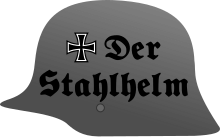
Back الخوذة الحديدية، رابطة جنود الجبهة Arabic Der Stahlhelm, Bund der Frontsoldaten Breton Stahlhelm, Svaz frontových vojáků Czech Stahlhelm Danish Stahlhelm, Bund der Frontsoldaten German Στάλχελμ Greek Der Stahlhelm Esperanto Cascos de Acero Spanish Stahlhelm, Bund der Frontsoldaten Estonian Stahlhelm Finnish
This article needs additional citations for verification. (March 2020) |
 The logo of the organization | |
 Original flag of the organization | |
| Named after | Stahlhelm |
|---|---|
| Merged into | Sturmabteilung |
| Successor | Der Stahlhelm – Kampfbund für Europa (1951-2000) |
| Formation | 25 December 1918 |
| Founder | Franz Seldte[1] |
| Founded at | Magdeburg |
| Dissolved | 7 November 1935 (as Nationalsozialistischer Deutscher frontkämpfer-Bund (Stahlhelm)) |
| Type | Ex-servicemen's organization |
| Purpose | Maintain peace and order and foster comradeship founded in the field. |
| Headquarters | Berlin |
| Origins | End of World War I and the German Revolution of 1918 |
Area served | Weimar Republic (1918–1933) Nazi Germany (1933–1935) |
| Membership | 1,500,000 (1933 est.) |
Federal Leader | Franz Seldte |
Deputy Leader | Theodor Duesterberg |
Key people | August von Mackensen |
Publication |
|
| Subsidiaries |
|
| Affiliations | Deutschnationale Volkspartei |
Der Stahlhelm, Bund der Frontsoldaten (German: 'The Steel Helmet, League of Front-Line Soldiers'), commonly known as Der Stahlhelm ('The Steel Helmet'), was a revanchist ex-serviceman's association formed in Germany after the First World War. While claiming inspiration from Italian fascism, and excluding Jewish veterans, as supporters of a Hohenzollern restoration members distinguished themselves from Hitler's National Socialists under whom their clubs were eventually suppressed. After the Second World War, a Stahlhelm network was re-established in West Germany. Following a history of supporting fringe nationalist parties, the last functioning local association dissolved itself in 2000.
- ^ Stackelberg (2007). The Routledge Companion to Nazi Germany, p. 243.